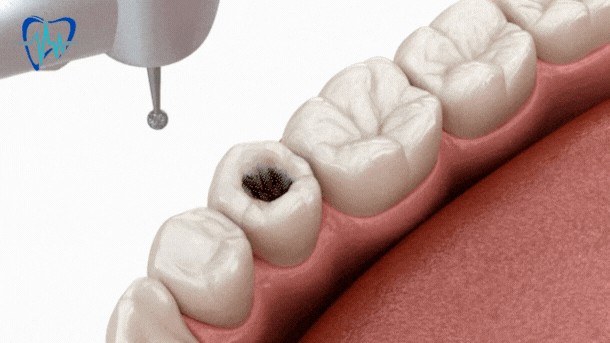What are dental fillings?
Dental fillings are single or combinations of metals, plastics, glass or other materials used to repair or restore teeth. One of the most common purposes for fillings is to "fill" a cavity, or a section of tooth that your dentist has removed because of deterioration. In addition, fillings can be used to restore teeth that have been eroded by abuse (such biting one's nails or grinding one's teeth).
The filling procedure
The first step during a dental filling is to numb the area near the affected tooth with a local anesthetic. This will help keep the patient comfortable throughout the procedure.
Afterward, the damaged or decayed tooth will be prepared for the dental restoration. The dentist will use a dental hand tool or laser to remove the damaged or decayed area of the tooth. They will use an acid gel to clean the area and eliminate bacteria thoroughly. Then, the filling material will be placed into the cavity.
The dentist will need to isolate the affected tooth to prevent the interference of moisture during the bonding process. Dental adhesive will be applied to the cleaned area and the filling material will be bonded to the tooth. For composite resin, the dentist will harden the filling with a unique UV light. Afterward, the tooth will be polished to a natural sheen.
Dental restoration aftercare
After completing the dental filling procedure, the dentist will discuss with the patient how to prevent decay from developing under or around the dental filling. The instructions will help prevent additional decay, especially in other teeth.
The dentist may recommend fluoride mouth rinses for patients with a high risk of cavities. Some patients can benefit from getting dental sealants over their molars to reduce the occurrence of decay.
Follow-up appointments and regular checkups are important to monitor the tooth and filling and for a professional dental cleaning.
Are there advantages and disadvantages to various filling materials?
Advantages and disadvantages of the various dental filling materials are as follows:
Advantages:
- Gold: Lasts at least 10 to 15 years, some say gold presents a pleasing appearance.
- Silver fillings (amalgams): Lasts at least 10 to 15 years, less expensive than composite fillings.
- Tooth-colored composite fillings: Shade can be closely matched to color of existing teeth, bonds to existing tooth providing additional support, commonly used for repairs other than cavity filling, sometimes less tooth needs to be removed compared with amalgams.
- Ceramics/porcelain: Lasts more than 15 years, more resistant to staining than composite resin material.
- Glass ionomer (acrylic and a specific type of glass material): Mostly used for fillings below the gum line, releases fluoride that can help protect from further tooth decay.
Disadvantages:
- Gold: More expensive than other materials, may require more than one office visit to place.
- Silver: May require more tooth to be removed to make space large enough to hold filling, creates grayish hue to the surrounding tooth structure, may have higher risk of tooth cracks and fractures due to wider degree of expansion and contraction, allergic potential in some people.
- Tooth-colored composite fillings: Lasts at least five years (less than the 10 to 15 years of other materials), may chip off tooth depending on location, can cost up to twice as much as amalgams, can take more time to place and/or additional visits.
- Ceramics: Can cost as much as gold.
- Glass ionomer: Is weaker than composite resin, more likely to wear and prone to fracture, lasts five years or less, costs comparable to composite fillings.
- Which Type of Filling is Best?
No one type of filling is best for everyone. What's right for you will be determined by the extent of the repair, whether you have allergies to certain materials, where in your mouth the filling is needed, and the cost. Considerations for different materials include:
- Gold fillings are made to order in a laboratory and then cemented into place. Gold inlays are well tolerated by gum tissues, and may last more than 20 years. For these reasons, many authorities consider gold the best filling material. However, it is often the most expensive choice and requires multiple visits.
- Amalgam (silver) fillings are resistant to wear and relatively inexpensive. However, due to their dark color, they are more noticeable than porcelain or composite restorations and are not usually used in very visible areas, such as front teeth.
- Composite (plastic) resins are matched to be the same color as your teeth and therefore used where a natural appearance is desired. The ingredients are mixed and placed directly into the cavity, where they harden. Composites may not be the ideal material for large fillings as they may chip or wear over time. They can also become stained from coffee, tea or tobacco, and do not last as long as other types of fillings generally from three to 10 years.
- Porcelain fillings are called inlays or onlays and are produced to order in a lab and then bonded to the tooth. They can be matched to the color of the tooth and resist staining. A porcelain restoration generally covers most of the tooth. Their cost is similar to gold.
If decay or a fracture has damaged a large portion of the tooth, a crown, or cap, may be recommended. Decay that has reached the nerve may be treated in two ways: through root canal therapy (in which nerve damaged nerve is removed) or through a procedure called pulp capping (which attempts to keep the nerve alive).
How should I care for my teeth with fillings?
To maintain your fillings, you should follow good oral hygiene practices:
- Visiting your dentist regularly (twice a year) for cleanings.
- Brush with a fluoride-containing toothpaste.
- Floss at least once daily.
Call your dentist if:
- Your tooth is extremely sensitive.
- You feel a sharp edge.
- You notice a crack in a filling or if a piece of the filling is missing.
Your dentist will take X-rays if he or she suspects that one of your fillings might be cracked or is “leaking” (when the sides of the filling don't fit tightly against the tooth, debris and saliva can seep down between the filling and the tooth, which leads to decay).
Tooth sensitivity after getting a dental filling is a common occurrence and can be caused by various factors. Here are some possible reasons:
- Dentin Exposure: Dental fillings are often used to treat cavities or areas of tooth decay. If the cavity was deep and close to the tooth's nerve (pulp), there might be some temporary sensitivity as a result of the dental work.
- Nerve Irritation: Dental procedures can sometimes irritate the dental pulp, which contains nerves and blood vessels. This irritation can cause temporary sensitivity. If the irritation persists or worsens, it may indicate a more significant issue, such as pulpitis.
- Type of Filling Material: Different filling materials have varying thermal conductivity properties. Some materials may conduct temperature changes more effectively than others, leading to increased sensitivity to hot or cold stimuli.
- Tooth Rehydration: During the dental filling procedure, the tooth may become dehydrated, which can temporarily increase sensitivity. As the tooth rehydrates over time, sensitivity may diminish.
- Bite Alignment: Changes in the way your teeth come together (occlusion) after a filling can cause sensitivity.
- Pre-existing Conditions: Individuals with pre-existing conditions like bruxism (teeth grinding) or gum recession may be more prone to post-filling sensitivity.
It's important to note that some degree of sensitivity immediately following a dental filling is normal. However, if the sensitivity persists or worsens over time, it's crucial to contact your dentist. They can assess the situation, determine the cause of the sensitivity, and recommend appropriate steps to address it, which may include adjustments to the filling or other interventions.
FAQ
In most cases, you can resume normal eating and drinking after getting a dental filling. However, it's advisable to avoid very hot or cold foods and beverages until any post-operative sensitivity subsides.
Yes, tooth-colored composite fillings are a popular alternative to traditional amalgam fillings. Composite fillings are made to match the color of the natural teeth, providing a more aesthetically pleasing result.



 Dental Checkup Services
Dental Checkup Services
 Our range of products
Our range of products
 Oral Care Blogs
Oral Care Blogs
